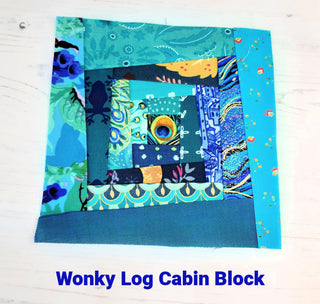The wonky log cabin is a great modern twist on the more traditional log cabin block. We made a scrappy version with a fussy cut centre, using our foundation paper.
To start with please download our free wonky log cabin template and print it onto foundation paper. Make sure the scale on your printer settings is set to custom and 100%. Use the test square to check the size is correct.

Cut around the outside of the square, then fold along the lines between the numbered sections. This will make it easier when you have to fold the paper back later.

Our foundation paper is semi transparent to allow for fabric placement, so you can fussy cut the centre like we have. Using fabric glue apply the first piece of fabric to the back of the paper so it more than covers piece 1 (with at least 1/4 an inch of excess fabric on all sides).

Fold back the paper on the line between 1 and 2, trim any fabric that goes beyond the quarter an inch seam allowance. I use the add a quarter ruler for this.

Choose a piece of fabric that more than covers shape 2 and lie it on top of piece 1 right sides together, aligning the fabrics on the edge that covers the line between shapes 1 and 2.

Take it over to your sewing machine and flip it so the fabrics are on the bottom and the paper on top. Sew along the line between pieces 1 and 2 using a small stitch. I use a stitch length of 1.3 for foundation piecing.

Fold the second piece of fabric over shape 2 and press into place.

Then fold the paper along the line between 1 and 3, repeat the earlier steps. Keep going to grow your wonky log cabin. When you have finished trim off any excess fabric around the edges, you don't need to leave a quarter an inch seam allowance as we have already added that to the paper.

Tear off the foundation paper from the back and press your finished block.

Why not check out our quilt block category for other free quilt block patterns? Or we have 10 free 6.5 inch quilt blocks included in our Quilter’s Workbook with a free sampler cushion project on our blog.
We quilted our wonky log cabin block and turned it into a funky mug rug.

